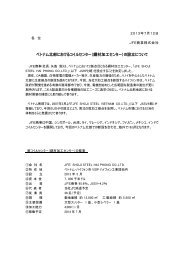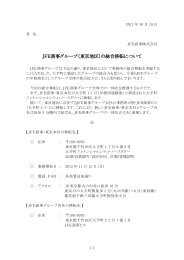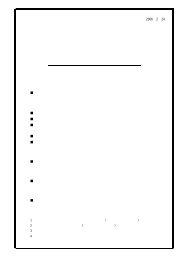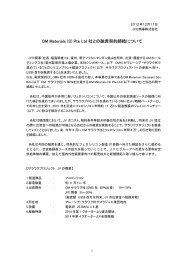Annual Report 2004 [PDF/1.1MB]
Annual Report 2004 [PDF/1.1MB]
Annual Report 2004 [PDF/1.1MB]
You also want an ePaper? Increase the reach of your titles
YUMPU automatically turns print PDFs into web optimized ePapers that Google loves.
Corporate Governance<br />
1. Basic Corporate Governance Policies<br />
Corporate governance reforms and other structural improvement<br />
measures aimed at establishing systems to<br />
make Kawasho more responsive to the fast-changing<br />
and highly competitive business environment were initiated<br />
after approval at the <strong>Annual</strong> Meeting of Shareholders<br />
on June 27, 2003. These reforms specifically entailed<br />
the introduction of an executive officer system in<br />
June 2003, which strengthened governance and management<br />
functions within the overall business structure<br />
by making a clear separation between business decision-making<br />
by the Board of Directors and management<br />
supervisory functions, and policy execution functions.<br />
This change served to clarify authority and responsibility<br />
within the new structure.<br />
In addition, recognizing the need for a more comprehensive<br />
approach to observance of laws and corporate<br />
ethics across the Kawasho Group, a Compliance Committee<br />
was established in May 2003.<br />
2. Corporate Governance System<br />
Kawasho has adopted the auditor-based system of corporate<br />
governance as specified in the Commercial<br />
Code of Japan. This system establishes the Meeting of<br />
Shareholders, the Board of Directors and the Board of<br />
Corporate Auditors as the principal governance structures.<br />
Kawasho has also introduced an executive officer<br />
system, under which executive officers are responsible<br />
for policy execution. Kawasho has not appointed<br />
any external directors. Of the four corporate auditors,<br />
three are external appointees, of whom two are parttime<br />
auditors.<br />
3. Internal Controls and Risk Management Status<br />
(1) Reforms to Board of Directors<br />
The decision-making and supervisory functions of<br />
the Board of Directors are separated from its role in operational<br />
execution through a clearer delineation of authority<br />
and responsibilities.<br />
With regard to corporate governance-related matters,<br />
the Board of Directors supervises operations by<br />
checking the legality and appropriateness of all operational<br />
moves and strategic decisions.<br />
The Board of Directors was reduced in size by an<br />
amendment to the Articles of Incorporation lowering<br />
the maximum number of directors from 35 to 15. This<br />
reform aimed to promote an increased volume of more<br />
dynamic debate while speeding up decision-making<br />
processes.<br />
(2) Introduction of executive officer system<br />
An executive officer system was introduced in June<br />
2003 to improve management functions. Appointed by<br />
the Board of Directors, executive officers have terms of<br />
1 year.<br />
Besides the President & CEO, the executive officers<br />
include appointees to positions at the levels of Senior<br />
Managing Executive Officer, Managing Executive Officer<br />
and Executive Officer.<br />
The Board of Directors has determined all executive<br />
officer roles and the division of responsibilities.<br />
A Board of Executive Officers has been established<br />
that reports directly to the President & CEO. This<br />
change aims to promote smooth communication channels<br />
between the directors and the executive officers,<br />
and between executive officers, thereby enabling better<br />
policy execution. This committee is composed of the<br />
President & CEO, all Senior Managing Executive Officers<br />
and Managing Executive Officers, and all Executive<br />
Officers.<br />
(3) Measures to strengthen compliance<br />
Establishment of Compliance Committee<br />
To raise company-wide awareness of compliance issues<br />
and to upgrade risk management capabilities, the<br />
Compliance Committee was established in May 2003.<br />
Its main tasks are to integrate management of compliance<br />
functions and to promote on a company-wide basis<br />
(including all affiliates) awareness of the importance<br />
of legal and regulatory compliance by executive<br />
officers and employees at every level of the organization.<br />
Chaired by the senior managing executive officer<br />
in charge of general and administrative affairs, the<br />
committee decides compliance-related policies and actions,<br />
and is responsible for overseeing a quick company-wide<br />
response in the event of any compliance violation.<br />
Compliance system<br />
In addition to the establishment of the Compliance<br />
Committee, a Compliance Officer (at director level) and<br />
compliance executives (at the levels of division heads,<br />
executive officers, and presidents of affiliated companies)<br />
were appointed to ensure the operation and maintenance<br />
of the compliance system.<br />
Institution of compliance violation reporting system<br />
Any Kawasho Group employee may report or discuss<br />
known compliance-related issues directly through a<br />
new system that facilitates reporting of any compliance<br />
violations through a mechanism independent of the operational<br />
chain of command. Part of the secretariat of<br />
the Compliance Committee, the Compliance Consultation<br />
Office provides this facility. The confidentiality of<br />
any information is strictly protected to ensure that informants’<br />
interests are not prejudiced by their actions.<br />
Compliance actions<br />
Led by the Compliance Committee, the following measures<br />
were taken during the year ended March <strong>2004</strong>:<br />
(a) Meetings were held to brief employees and presidents<br />
of affiliated companies on the establishment of<br />
the Compliance Committee.<br />
(b) Compliance manuals were distributed to all employees<br />
and executive officers of Kawasho and affiliated<br />
companies.<br />
(c) Employees and branch managers of Kawasho and<br />
presidents of affiliated companies received management<br />
level-specific training on compliance issues (including<br />
case studies of compliance violations).<br />
12


![Annual Report 2004 [PDF/1.1MB]](https://img.yumpu.com/28997981/12/500x640/annual-report-2004-pdf-11mb.jpg)






![Annual Report 2002 [PDF/1.6MB]](https://img.yumpu.com/44293603/1/190x248/annual-report-2002-pdf-16mb.jpg?quality=85)




